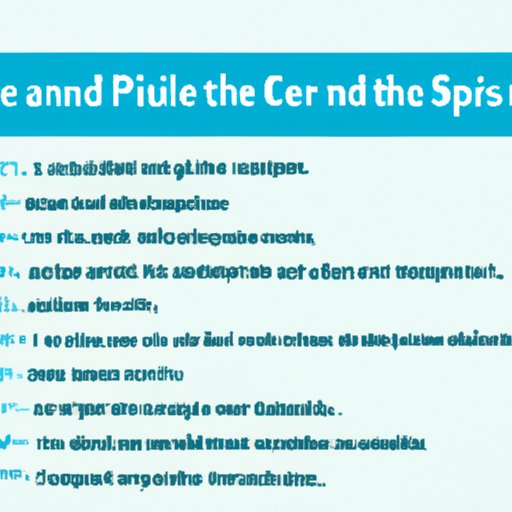Introduction
When it comes to crafting compelling and effective writing, one of the key elements is mastering the art of sentence structure. And while it’s easy to recognize simple and compound sentences, identifying complex sentences can be more challenging. But fear not – in this article, we’ll explore the definition and elements of complex sentences, discuss tips for identifying them within different sentence structures, and provide strategies for incorporating more complex sentences into your own writing.
Exploring the Elements of Complex Sentences: Unpacking the Definition and Identifying Examples
Before we delve into the specifics of complex sentences, let’s first define what they are. Simply put, a complex sentence is a sentence that contains both an independent clause and at least one dependent clause. An independent clause can stand alone as a complete sentence, while a dependent clause cannot.
Here’s an example of a complex sentence: “Although I love chocolate, I try to limit my consumption due to its high calorie content.” In this sentence, “although I love chocolate” is the dependent clause, while “I try to limit my consumption due to its high calorie content” is the independent clause.
Sentence Structure 101: Understanding Complex Sentences and How to Spot Them
To effectively identify complex sentences in your writing (or in the writing of others), it’s important to have a basic understanding of sentence structure. There are four main types of sentence structures:
- Simple sentence: contains only one independent clause (e.g. “I went for a run.”)
- Compound sentence: contains two or more independent clauses joined by a coordinating conjunction (e.g. “I went for a run, and then I took a shower.”)
- Complex sentence: contains one independent clause and at least one dependent clause (e.g. “Although I was tired, I went for a run.”)
- Compound-complex sentence: contains two or more independent clauses and at least one dependent clause (e.g. “Although I was tired, I went for a run, and then I took a shower.”)
To spot complex sentences within these structures, look for clauses that cannot stand alone as complete sentences. Dependent clauses are often signaled by subordinating conjunctions such as “although,” “because,” “since,” and “when.”
Mastering the Art of Sentence Structure: A Guide to Writing Complex Sentences in Your Prose
So why should you strive to use complex sentences in your writing? For one, they allow you to convey more information in a single sentence. They also add variety and complexity to your writing, making it more engaging and dynamic. Here are some tips for crafting effective complex sentences:
- Vary sentence length: Using a mix of sentence lengths – including longer, more complex sentences – can add rhythm and flow to your writing.
- Vary sentence structure: Don’t rely too heavily on one sentence structure. Instead, experiment with different combinations of simple, compound, and complex sentences.
- Use transitions: Transitions such as “however,” “therefore,” and “nevertheless” can help connect ideas within a sentence and add coherence to your writing.
- Use subordinating conjunctions: Subordinating conjunctions can help you create complex sentences by introducing dependent clauses. Just be careful not to overuse them and create convoluted sentences.
Here’s an example of an effective complex sentence: “Although I was exhausted from my long day at work, I mustered the energy to attend my son’s soccer game and cheer him on from the sidelines.”
From Dependent to Independent: Decoding the Anatomy of a Complex Sentence
While dependent clauses cannot stand alone as complete sentences, they can be transformed into independent clauses to create more complex sentences. This process involves identifying the subject and verb within the dependent clause and adding any necessary words to make the clause an independent sentence.
Here’s an example: “After the storm passed, we ventured outside to survey the damage.” To turn the dependent clause “after the storm passed” into an independent sentence, we add a subject (“we”) and verb (“ventured”) to make it a complete sentence.
Why Simple Isn’t Always Better: Tips for Building More Complex Sentences in Your Writing
While there’s certainly a time and place for simple sentences, relying too heavily on them can make your writing feel choppy and unsophisticated. Here are some tips for building more complex sentences in your writing:
- Use descriptive adjectives and adverbs: Adding descriptive language to your sentences can help you create a more complex and nuanced picture of your subject matter.
- Combine simple sentences: By combining shorter sentences into longer, more complex ones, you can create a more cohesive and engaging piece of writing.
- Use parallel structure: Parallel structure involves using the same grammatical structure for multiple parts of a sentence. This technique can help you create more complex and impactful sentences.
Here’s an example of an effective, complex sentence: “As I gazed out at the tranquil, azure waters of the ocean and felt the warm sun on my face, I couldn’t help but feel a sense of profound contentment.”
Conclusion
Understanding complex sentences is key to crafting compelling, sophisticated writing. By recognizing the elements of a complex sentence, identifying them within different sentence structures, and mastering the art of writing them, you can take your writing to the next level. So next time you sit down to write, challenge yourself to incorporate more complex sentences – your readers (and your writing) will thank you.
